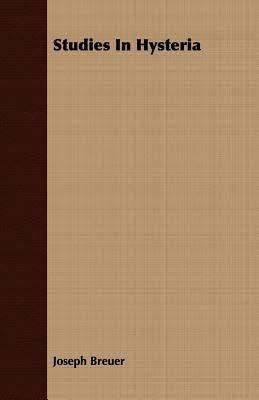7.8 /10 1 Votes7.8
Original title Studien über Hysterie Originally published 1895 | 3.9/5 Goodreads | |||||||||||||||||||||||||||||||||
 | ||||||||||||||||||||||||||||||||||
Preceded by New Introductory Lectures on Psychoanalysis Similar Sigmund Freud books, Psychoanalysis books | ||||||||||||||||||||||||||||||||||
Freud and breuer studies on hysteria 1893 1895 part 2
Studies on Hysteria (German: Studien über Hysterie) is an 1895 book by Sigmund Freud and Josef Breuer. It consists of a joint introductory paper (reprinted from 1893); followed by five individual studies of "hysterics" – Breuer's famous case of Anna O. (real name: Bertha Pappenheim), seminal for the development of psychoanalysis, and four more by Freud; and finishing with a theoretical essay by Breuer and a more practice-oriented one on therapy by Freud.
Contents
- Freud and breuer studies on hysteria 1893 1895 part 2
- Introduction to hysteria public lecture dr tim nicholson
- Summary
- Reception and influence
- Translations
- References
Introduction to hysteria public lecture dr tim nicholson
Summary
Freud sees symptomology as stratified in an almost geological way, with the outermost strata being easily remembered and accepted, while “the deeper one goes the more difficult it is to recognise the recollections that are surfacing”.
Reception and influence
Breuer's work with Bertha Pappenheim provided the founding impetus for psychoanalysis, as Freud himself would acknowledge. In their preliminary (1893) paper, both men agreed that “the hysteric suffers mainly from reminiscences”. Freud however would come to lay more stress on the causative role of sexuality in producing hysteria, as well as gradually repudiating Breuer's use of hypnosis as a means of treatment. Some of the theoretical scaffolding of the Studies – "strangulated affect", hypnoid state – would be abandoned with the crystallisation of psychoanalysis as an independent technique. However, many of Freud’s clinical observations – on mnenmic symbols or deferred action for example – would continue to be confirmed in his later work. At the same time, Breuer’s theoretical essay, with its examination of the principle of constancy, and its differentiation of bound and mobile cathexis, would continue to inform Freud’s thinking as late as the twenties and the writing of Beyond the Pleasure Principle.
At the time of its release, Studies on Hysteria tended to polarise opinion, both within and outside by the medical community. While many were critical, Havelock Ellis offered an appreciative account, while a leading Viennese paper would characterise the work as “the kind of psychology used by poets”. Studies on Hysteria received a positive review from psychiatrist Eugen Bleuler, although Bleuler nevertheless suggested that the results Freud and Breuer reported could have been the result of suggestion. Philosopher Mikkel Borch-Jacobsen and psychologist Sonu Shamdasani comment that Studies on Hysteria gave Freud, "a certain local and international notoriety". Borch-Jacobsen and Shamdasani write that, contrary to what Freud and Breuer claimed, Freud "always knew that the treatment of Bertha Pappenheim...had not been an unmitigated success".
